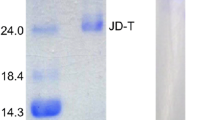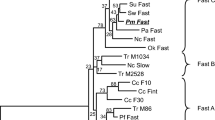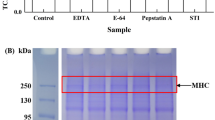Abstract
Purpose Silver carp is widely cultured in China (the product reached 3.5 million ton per year), and approximately 20% of the non-edible viscera are discarded. Utilization of the viscera leads to a reduction in waste. Our previous study showed that silver carp produced two types of myosin isoforms, thermostable myosin in summer and unstable one in winter, for the adaptation of the environmental changes. Therefore, in this study, we purified trypsins from silver carp in summer and winter samples to investigate their thermostabilities.
Methods
Trypsins from summer and winter samples were purified by a series of chromatographies. The temperature dependence of trypsins was determined at pH 8.0 in the range of 20–80 °C, and the effect of temperature on the thermostability was determined by measuring the remaining activity after the incubation at pH 8.0 for 15 min in the range of 20–75 °C.
Results
From the summer sample, two trypsins (SSC-T1 and SSC-T2) were purified 63- and 72-fold with the yields of 24 and 21%, respectively, and a trypsin (WSC-T) was purified 81-fold with a yield of 40% from the winter sample. SSC-T1, SSC-T2 and WSC-T showed the same enzymatic characteristics, especially their optimum temperature (65 °C) and thermostability (stable below 63 °C in 15-min incubation) were similar to mammalian trypsins. Additionally, all were stable at 30 °C for 8 h in the presence of calcium-ion.
Conclusion
These data indicated the silver carp viscus has a potential for thermostable trypsin source all the year round.
Graphic Abstract
Thermostable characteristics of trypsins from viscera of freshwater fish including silver carp (Hypophthalmichthys molitrix).





Similar content being viewed by others
References
Rypniewski, W., Perrakis, A., Vorgias, C.E., Wilson, K.S.: Evolutionary divergence and conservation of trypsin. Protein Eng. Des. Sel. 7, 57–64 (1994). https://doi.org/10.1093/protein/7.1.57
Walsh, K.A.: Trypsinogens and trypsins of various species. Methods Enzymol. 19, 41–63 (1970). https://doi.org/10.1016/0076-6879(70)19006-9
Kossiakoff, A.A., Chambers, J.L., Kay, L.M., Stroud, R.M.: Structure of bovine trypsinogen at 1.9A resolution. Biochemistry 16, 654–664 (1977). https://doi.org/10.1021/bi00623a016
Gupta, R., Beg, Q., Lorenz, P.: Bacterial alkaline proteases: molecular approaches and industrial applications. Appl. Microbiol. Biotechnol. 59, 15–32 (2002). https://doi.org/10.1007/s00253-002-0975-y
Chakrabarti, S., Guha, S., Majumder, K.: Food-derived bioactive peptides in human health: challenges and opportunities. Nutrients 10, 1738 (2018). https://doi.org/10.3390/nu10111738
Kitade, Y., Miyabe, Y., Yamamoto, Y., Takeda, H., Shimizu, T., Yasui, H., Kishimura, H.: Structural characteristics of phycobiliproteins from red alga Mazzaella japonica. J. Food Biochem. 42, e12436 (2018). https://doi.org/10.1111/jfbc.12436
Furuta, T., Miyabe, Y., Yasui, H., Kinoshita, Y., Kishimura, H.: Angiotensin I converting enzyme inhibitory peptides derived from phycobiliproteins of dulse Palmaria palmata. Mar. Drugs 14, e32 (2016). https://doi.org/10.3390/md14020032
Tavano, O.L., Berenguer-Murcia, A., Secundo, F., Fernandez-Lafuente, R.: Biotechnological applications of proteases in food technology. Compr. Rev. Food Sci. Food Saf. 17, 412–436 (2018). https://doi.org/10.1111/1541-4337.12326
Bougatef, A.: Trypsins from fish processing waste: characteristics and biotechnological applications—comprehensive review. J. Clean. Prod. 57, 257–265 (2013). https://doi.org/10.1016/j.jclepro.2013.06.005
Zamani, A., Benjakul, S.: Trypsin from unicorn leatherjacket (Aluterus monoceros) pyloric caeca: purification and its use for preparation of fish protein hydrolysate with antioxidative activity. J. Sci. Food Agric. 96, 962–969 (2016). https://doi.org/10.1002/jsfa.7172
Hidalgo, M.C., Urea, E., Sanz, A.: Comparative study of digestive enzymes in fish with different nutritional habits: proteolytic and amylase activities. Aquaculture 170, 267–283 (1999). https://doi.org/10.1016/S0044-8486(98)00413-X
Kishimura, H., Hayashi, K., Miyashita, Y., Nonami, Y.: Characteristics of two trypsin isozymes from the viscera of Japanese anchovy (Engraulis japonica). J. Food Biochem. 29, 459–469 (2005). https://doi.org/10.1111/j.1745-4514.2005.00029.x
Kishimura, H., Hayashi, K., Miyashita, Y., Nonami, Y.: Characteristics of trypsins from the viscera of true sardine (Sardinops melanostictus) and the pyloric ceca of arabesque greenling (Pleuroprammus azonus). Food Chem. 97, 65–70 (2006). https://doi.org/10.1016/j.foodchem.2005.03.008
Kishimura, H., Tokuda, Y., Klomklao, S., Benjakul, S., Ando, S.: Enzymatic characteristics of trypsin from the pyloric ceca of spotted mackerel (Scomber australasicus). J. Food Biochem. 30, 466–477 (2006). https://doi.org/10.1111/j.1745-4514.2006.00076.x
Kishimura, H., Tokuda, Y., Klomklao, S., Benjakul, S., Ando, S.: Comparative study on enzymatic characteristics of trypsins from the pyloric ceca of yellow tail (Seriola quinqueradiata) and brown hakeling (Physiculus japonicus). J. Food Biochem. 30, 521–534 (2006). https://doi.org/10.1111/j.1745-4514.2006.00079.x
Kishimura, H., Tokuda, Y., Yabe, M., Klomklao, S., Benjakul, S., Ando, S.: Trypsins from the pyloric ceca of jacopever (Sebastes schlegeli) and elkhorn sculpin (Alcichthys alcicornis): isolation and characterization. Food Chem. 100, 1490–1495 (2007). https://doi.org/10.1016/j.foodchem.2005.11.040
Kishimura, H., Klomklao, S., Benjakul, S., Chun, B.S.: Characteristics of trypsin from the pyloric ceca of walleye pollock (Theragra chalcogramma). Food Chem. 106, 194–199 (2008). https://doi.org/10.1016/j.foodchem.2007.05.056
Kishimura, H., Klomklao, S., Benjakul, S., Chun, B.S.: Comparative study on thermal stability of trypsin from the pyloric ceca of threadfin hakeling (Laemonema Longipes). J. Food Biochem. 34, 50–65 (2010). https://doi.org/10.1111/j.1745-4514.2009.00263.x
Klomklao, S., Benjakul, S., Visessanguan, W., Kishimura, H., Simpson, B.K., Saeki, H.: Trypsins from yellowfin tuna (Thunnus albacores) spleen: purification and characterization. Comp. Biochem. Physiol. B: Biochem. Mol. Biol. 144B, 47–56 (2006). https://doi.org/10.1016/j.cbpb.2006.01.006
Klomklao, S., Benjakul, S., Visessanguan, W., Kishimura, H., Simpson, B.K.: Purification and characterization of trypsin from spleen of tongol tuna (Thunnus tonggol). J. Agric. Food Chem. 54, 5617–5622 (2006). https://doi.org/10.1021/jf060699d
Klomklao, S., Benjakul, S., Visessanguan, W., Kishimura, H., Simpson, B.K.: Purification and characterization of trypsins from skipjack tuna (Katsuwonus pelamis) spleen. Food Chem. 100, 1580–1589 (2007). https://doi.org/10.1016/j.foodchem.2006.01.001
Klomklao, S., Benjakul, S., Visessanguan, W., Kishimura, H., Simpson, B.K.: Trypsin from the pyloric ceca of bluefish (Pomatomus saltatrix). Comp. Biochem. Physiol. B: Biochem. Mol. Biol. 148B, 382–389 (2007). https://doi.org/10.1016/j.cbpb.2007.07.004
Klomklao, S., Benjakul, S., Visessanguan, W., Kishimura, H., Simpson, B.K.: A 29 kDa protease from the digestive glands of Atlantic bonito (Sarda sarda): recovery and characterization. J. Agric. Food Chem. 55, 4548–4553 (2007). https://doi.org/10.1021/jf063319x
Klomklao, S., Kishimura, H., Benjakul, S., Simpson, B.K., Visessanguan, W.: Cationic trypsin: a predominant proteinase in Pacific saury (Cololabis saira) pyloric ceca. J. Food Biochem. 34, 1105–1123 (2010). https://doi.org/10.1111/j.1745-4514.2010.00352.x
Fuchise, T., Kishimura, H., Sekizaki, H., Nonami, Y., Kanno, G., Klomklao, S., Benjakul, S., Chun, B.S.: Purification and characteristics of trypsins from cold-zone fish, Pacific cod (Gadus macrocephalus) and saffron cod (Eleginus gracilis). Food Chem. 116, 611–616 (2009). https://doi.org/10.1016/j.foodchem.2009.02.078
Kanno, G., Kishimura, H., Yamamoto, J., Ando, S., Shimizu, T., Benjakul, S., Klomklao, S., Nalinanon, S., Chun, B.S., Saeki, H.: Cold-adapted structural properties of trypsins from walleye pollock (Theragra chalcogramma) and Arctic cod (Boreogadus saida). Eur. Food Res. Technol. 233, 963–972 (2011). https://doi.org/10.1007/s00217-011-1592-8
Kanno, G., Kishimura, H., Ando, S., Klomklao, S., Nalinanon, S., Benjakul, S., Chun, B.S., Saeki, H.: Structural properties of trypsin from cold-adapted fish, arabesque greenling (Pleurogrammus azonus). Eur. Food Res. Technol. 232, 381–399 (2011). https://doi.org/10.1007/s00217-010-1404-6
Kanno, G., Yamaguchi, T., Kishimura, H., Yamaha, E., Saeki, H.: Purification and characteristics of trypsin from masu salmon (Oncorhynchus masou) cultured in fresh-water. Fish Physiol. Biochem. 36, 637–645 (2010). https://doi.org/10.1007/s10695-009-9336-4
Kanno, G., Klomklao, S., Kumagai, Y., Kishimura, H.: A thermostable trypsin from freshwater fish Japanese dace (Tribolodon hakonensis): a comparison of the primary structures among fish trypsins. Fish Physiol. Biochem. in press (2018)
Liu, Z.Y., Wang, Z., Xu, S.Y., Xu, L.N.: Two trypsin isoforms from the intestine of the grass carp (Ctenopharyngodon idellus). J. Comp. Physiol. B. 177, 655–666 (2007). https://doi.org/10.1007/s00360-007-0163-6
Khangembam, B.K., Chakrabarti, R.: Trypsin from the digestive system of carp Cirrhinus mrigala: purification, characterization and its potential application. Food Chem. 175, 386–394 (2015). https://doi.org/10.1016/j.foodchem.2014.11.140
Cao, M.J., Osatomi, K., Suzuki, M., Hara, K., Tachibana, K., Ishihara, T.: Purification and characterization of two anionic trypsins from the hepatopancreas of carp. Fish. Sci. 66, 1172–1179 (2000). https://doi.org/10.1046/j.1444-2906.2000.00185.x
Yuan, C., Kaneniwa, M., Wang, X., Chen, S., Cheng, Y., Qu, Y., Fukuda, Y., Konno, K.: Seasonal expression of 2 types of myosin with different thermostability in silver carp muscle (Hypophthalmichthys molitrix). J. Food Sci. 71, C39–C43 (2006). https://doi.org/10.1111/j.1365-2621.2006.tb12386.x
Kishimura, H., Hayashi, K.: Isolation and characteristics of trypsin from pyloric ceca of the starfish Asterina pectinifera. Comp. Biochem. Physiol. B: Biochem. Mol. Biol. 132, 485–490 (2002). https://doi.org/10.1016/S1096-4959(02)00062-3
Lowry, O.H., Rosebrough, N.J., Farr, A.L., Randall, R.J.: Protein measurement with the Folin phenol reagent. J. Biol. Chem. 193, 265–273 (1951)
Laemmli, U.K.: Cleavage of structural proteins during the assembly of the head of bacteriophage T4. Nature 227, 680–685 (1970). https://doi.org/10.1038/227680a0
Hummel, B.C.W.: A modified spectrophotometric determination of chymotrypsin, trypsin, and thrombin. Can. J. Biochem. Physiol. 37, 1393–1399 (1959). https://doi.org/10.1139/o59-157
Klomklao, S., Benjakul, S., Visessanguan, W.: Comparative studies on proteolytic activity of spleen extracts from three tuna species commonly used in Thailand. J. Food Biochem. 28, 355–372 (2004). https://doi.org/10.1111/j.1745-4514.2004.05203.x
Jones, D.A., Kamarudin, M.S., Vay, L.L.: The potential for replacement of live feeds in larval culture. J. World Aquacult. Soc. 24, 199–210 (1993). https://doi.org/10.1111/j.1749-7345.1993.tb00009.x
Ruan, G.L., Li, Y., Gao, Z.X., Wang, H.L., Wang, W.M.: Molecular characterization of trypsinogens and development of trypsinogen gene expression and tryptic activities in grass carp (Ctenopharyngodon idellus) and topmouth culter (Culter alburnus). Comp. Biochem. Physiol. B: Biochem. Mol. Biol. 155, 77–85 (2010). https://doi.org/10.1016/j.cbpb.2009.10.005
Klomklao, S., Benjakul, S., Kishimura, H., Chaijan, M.: 24 kDa Trypsin: a predominant protease purified from the viscera of hybrid catfish (Clarias macrocephalus × Clarias gariepinus). Food Chem. 129, 739–746 (2011). https://doi.org/10.1016/j.foodchem.2011.05.014
Bkhairia, I., Khaled, H.B., Ktari, N., Miled, N., Nasri, M., Ghorbel, S.: Biochemical and molecular characterisation of a new alkaline trypsin from Liza aurata: structural features explaining thermal stability. Food Chem. 196, 1346–1354 (2016). https://doi.org/10.1016/j.foodchem.2015.10.058
Ahsan, M.N., Funabara, D., Watabe, S.: Molecular cloning and characterization of two isoforms of trypsinogen from anchovy pyloric ceca. Mar. Biotechnol. 3, 80–90 (2001). https://doi.org/10.1007/s101260000055
Klomklao, S., Benjakul, S.: Two trypsin isoforms from albacore tuna (Thunnus alalunga) liver: purification and physicochemical and biochemical characterization. Int. J. Biol. Macromol. 107, 1864–1870 (2018). https://doi.org/10.1016/j.ijbiomac.2017.10.059
Walsch, K.A.: Trypsinogens and trypsins of various species. Method Enzymol. 19, 41–46 (1970). https://doi.org/10.1016/0076-6879(70)19006-9
Hermodson, M.A., Ericsson, L.H., Neurath, H., Walsh, K.A.: Determination of the amino sequence of porcine trypsin by sequenator analysis. Biochemistry 12, 3146–3153 (1973). https://doi.org/10.1021/bi00741a002
Pinsky, K.S.: Differential regulation of trypsinogen: mRNA translation full-length mRNA sequences encoding two oppositely charged trypsinogen isoenzymes in the dog pancreas. Mol. Cell. Biol. 5, 2669–2676 (1985). https://doi.org/10.1128/MCB.5.10.2669
Author information
Authors and Affiliations
Corresponding author
Ethics declarations
Conflict of interest
The authors declare that they have no conflict of interest.
Additional information
Publisher's Note
Springer Nature remains neutral with regard to jurisdictional claims in published maps and institutional affiliations.
Rights and permissions
About this article
Cite this article
Abe, K., Yuan, C., Kumagai, Y. et al. The Potential of Freshwater Fish Viscus from Silver Carp Hypophthalmichthys molitrix for Trypsin Source. Waste Biomass Valor 11, 3971–3978 (2020). https://doi.org/10.1007/s12649-019-00717-7
Received:
Accepted:
Published:
Issue Date:
DOI: https://doi.org/10.1007/s12649-019-00717-7




